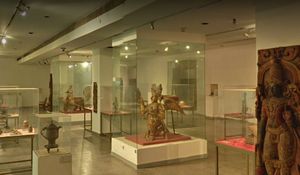As Covid seems to be ebbing and large parts of the nation have begun to return to normal life, the question arises: will this mean more visitors to our museums? I have my doubts. It is striking that despite our immeasurably rich heritage, our museums have not been able to attract the levels of engagement of any of their western counterparts.
For instance, it is a travesty that in the two years between 2016 and 2018, our National Museum had roughly 5.5 lakh visitors in total, whereas the New York’s Metropolitan Museum of Art hosted 70 lakh visitors in 2017 alone.
There are a number of factors responsible for the decline in our country’s museums and their ability to engage audiences, that have nothing to do with Covid. Official apathy is a key reason. Step into an Indian museum today and one is invariably taken aback by the state of affairs—be it exhibits falling apart, or anodyne captions that seldom convey the richness of the artefact one is observing, or even the availability of resources to guide visitors through what the museum has to offer.
Besides lines of restless schoolchildren who are essentially compelled to tour dusty museums and look interested, for most Indians, a visit to the museum is a decidedly dreary proposition: there are artefacts, but do they speak to you? Do they tell you, beyond tedious plaques and cards, of what they represent or what their age witnessed?
Museums are homes to objects—but they must also serve as repositories of legacies, of tales of people and societies, manifesting also ideas and thought. We in India have failed at this. Indians will line up in Rome or London or Paris (or for that matter Abu Dhabi) outside iconic galleries, seeking to glimpse the Mona Lisa or unravel an Egyptian mummy, hoping to educate themselves in the history of distant lands. But they will not bother to queue outside the Indian Museum, Kolkata.
Of course there is much to appreciate around the world. When I launched the British edition of my book on British colonialism, under the blunt title Inglorious Empire, one of my events was at the Victoria and Albert Museum, in dialogue with its director—while on the floor beneath us stood the famous animated tiger of Tipu Sultan, mauling a British redcoat. That is one museum artefact that, even more than the Kohinoor, I would love to see back in India! But even without the treasures the British have looted, there is much in India itself. Yet the challenges facing museums are growing, and have not been helped by significant delays in appointments to key posts or successive budget cuts to the ministry of culture. But there are reasons beyond the government as well.
Access has always been an important barrier in our ability to enjoy the richness of our museums—not just physical access but also access in terms of language and comprehension, although efforts have been made to address this to some extent through audio guides in various Indian languages. This is where online museums come in.
Museums, after all, cannot just be buildings full of attractive things—they must also offer an education, and a live, dynamic space where new art is constantly created, even as the old is respectfully enshrined.
Putting museums online provides the answer. The marriage of art and technology may well hold the key not just for the future survivability of our nation’s museums, but could define the manner in which subsequent generations engage with and explore the cultural heritage that they have inherited. Interactivity, easy access, cultural education, all become easier as the ‘virtual museum’ brings the collections to your home. Art history comes alive with the integration of digital technology.
Conservators are using new age methods like laser technologies and 3D-imaging technologies for improved and accurate conservation and restoration techniques.
Technology like Virtual Reality (VR) and Augmented Reality (AR) makes exhibitions come alive. An NRI family based in the Gulf or the US can raise their children with access to meaningful resources on India’s rich traditions.
Save our museums—take them online!
editor@theweek.in


